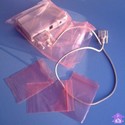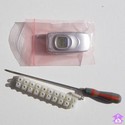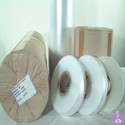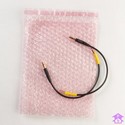Welcome to Antistaticbagsdirect.com
If you need to know what antistatic bags are, what it is used for or where to buy antistatic bags for low prices you are at the right place. Find answers to your questions for antistatic bags or static sheilding bags here.
What are Antistatic bags?
|
An antistatic bag is a plastic bag for devices sensitive to electrostatic discharge. Static travels around the bag and dissipates before it has a chance to damage contents when shipping or storing. These bags are usually plastic and have a distinctive color (silvery for metalized Mylar and other similar plastics, pink or black for polyethylene). The polyethylene variant may also take the form of foam or bubble wrap, either as sheets or bags. |

|
Types of Antistatic bags
Flat Antistatic BagsProtect electronic components from static build-up. Constructed from pink antistatic polyethylene film. Keeps products clean and moisture free. |

|
Gripseal antistatic bagsGripseal antistatic bag offers the same properties plus the security and convenience of a zipper top. The zipper top closes securely to protect against damage from dust and moisture. |

|
AntiStatic Poly TubingAntiStatic Poly Tubing are ideal to make your own antistatic poly bags. Offering excellent resistance to static discharge. Static dissipative, non-corrosive pink polyethylene is heat sealable. Seal with Poly Tubing Sealers. |

|
Antistatic Bubble BagsAntistatic Bubble Bags providing maximum protection against static discharge for relays, resistors and other static sensitive electronic components. Industrial bubble with a nylon barrier that provides very good cushioning. |

|
Features & Benefits of Anti Static Bags
- Inexpensive
- Simple design and production
- Antistatic agent or material on/in film
- Eliminates the possibility of incurring loss of static damage - prevents the generation of static electricity
- Perfect for packging, storing and shipping non-sensitive and sensitive electronic components
- Surface resistance is less than 1012 ohms/sq.
Question & Answer on Anti Static Bags
Question. I have two questions about one material. Anti-stat bags.
1. How effective are anti-stat bags with a relative humidity of less than 20 % and temperatures as high as 110 degrees Fahrenheit.
2. How do you put a spec on an anti-stat (ohms/sq. etc.) bag to ensure maximum protection and re-use?
Answer.The clear static dissipative polyethylene (PE) that high quality vendors use in their bags is far superior than the "topically treated washed" pink poly products.
Dissipative and metallized shielding bags are made with volume loaded polyethylene which cannot be washed off and is inherent in the film. The PE resin that we use and all the additives are developed to minimize contamination.
The antistatic dissipative clear bags are pre-conditioned and tested at both 50% and 12.5% RH levels to have a surface resistivity of less than 1x10^11 ohms. (old nomenclature = ohms/square)
Testing:
You can perform two test to ensure the proper operation of the bags:
1. perform a resistance test on the bag film to < 1x10^11 ohms @100 volts [using two five pound electrodes and megohmeter per esd s11.31-1994 and esd ds20.20-1998]
2. perform a tribocharge test, yielding static decay of less than or equal to 140 milliseconds, per FTMS 101C, Method 4046
Question. What is the recommendation or guidelines in determining when Anti Static shielded bags are no longer any good, i.e. crinkled or have small puncture holes, and put out of service?
Answer.All your answers are in the MIL-B-81705C Standard document. Specifically, an anti-static shielding bag (type III) can be considered no good if it meets any of the following conditions:
- and has a surface resistivity greater than 1x10^12 ohms/sq both inside and out and less than 1x10^5 ohms/sq on the inside.
- has a static decay rate exceeding 2.0 seconds
- the bag delaminates as defined in section 4.8.4.1 in MIL-B-81705C
- punctures over 6.0 lbs
- does not attenuate EMI at least 10 dB
- doesn't shield an ESD event under 30 kilovolts
In general, a metallized shielding bag may still shield if it has crinkled or acquired small holes because of the Faraday affect, but it is safer to discard these bags and err on the conservative side. It would probably cost more to test and qualify the bag then to replace it.
Affiliates
Because we mentioned antistatic grip seal bags and antistatic bubble bags we thought these websites to be useful for more information about each of the bags.
Please visit www.discountselfsealbags.co.uk for grip seal bags.
Please visit www.bargainbubblebags.co.uk for bubble bags.